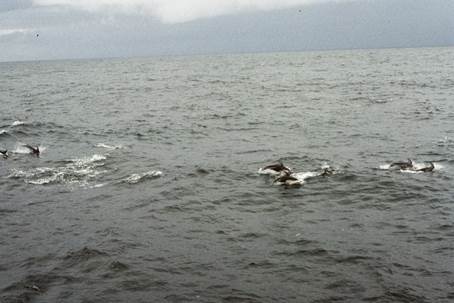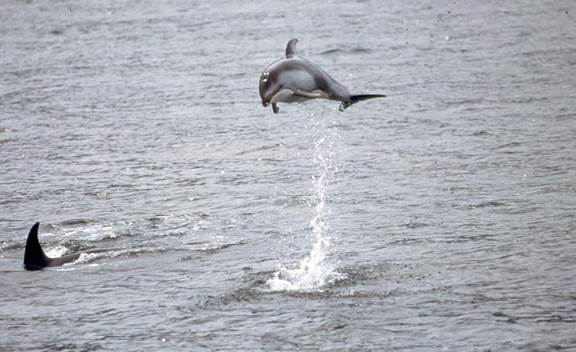They are seen in numbers varying from a dozen to many hundreds, tumbling over the surface of the sea, or making arching leaps, plunging again on the same curve, or darting high and falling diagonally sideways upon the water… accompanied by a report that may be heard at some distance.” C.M. Scammon, 1874.
These are sleek member of the Order Cetecea – whales and dolphins and the Odontoceti (parvorder) – or toothed whales. The have a short, rounded, thick beak with 23 to 32 rounded and slightly curved teeth in the upper and lower jaw – with an average of 60 teeth total. They are a strong and fast swimmer and appear quite enthusiastic to ride the bow wave of a ship, often hanging around for extended periods. And they are often found in large groups (herds) of 100 – 200 individuals and “super-groups” of more than 300. Because of some recent genetics work the actual genus designation appears in flux and a new genus has been proposed – we’ll see where this ends up.
The Pacific white-sided dolphin is a rather attractive dolphin with a black back and its sides are light gray with thin, white stripes that extend from above the eye along the sides, widening towards the tail; its belly is white. It has a black beak and lips and a black ring around each eye. They grow to 7 or 8 feet long and about 300 lbs. The generally eat squid and small schooling fish such as anchovies, herring, sardines, and hake. Scientists believe that they mostly hunt at night.
Their range is the North Pacific extending from Amchitka Island in the Aleutians to the Gulf of Alaska south to the tip of Baja California, and off the coast of Asia from the Kuril Islands to Japan. It was first described in 1865 by Theodore Nicholas Gill – an eminent ichthyologist and professor of zoology at George Washington University and prominent Smithsonian associate who supposedly got interested in his chosen profession by wandering around New York City’s Fulton Fish Market as a youngster.
As with all mammals they have the ability to control their body temperature (endothermic), feed their young milk, and have hair (at least in some life stage). In the case of dolphins they lose their hair in the embryonic stage. They also retain vestigial hind legs – remnant floating bones in their pelvic girdle – representing the cetacean’s evolutionary link to the land, which they eventually abandoned for the return to the sea.
They become sexually mature between 7 – 10 years old. Calves are born in the summer after a 12 month long gestation period – calves at birth weigh about 30 lbs. Because of the investment in raising young, females give birth every other year or every third year. Calves will nurse for about 6 months before weaning.
When I worked on a fishing boat in the Gulf of Alaska we came across this species regularly. One day I was working the catch below deck, hauling around my sample baskets of fish and processing these. There was a mild sea but it was one of those days where I seemed to be stumbling around, not getting my feet beneath me. The water was sloshing around my ankles, I was tired, and it was about 50 degrees. My fingers and toes were cold.
Then the captain came below deck and pulled at me vigorously – Jim-masen, come!! And he frantically motioned me up the steep metal stairs to the deck. At first I thought the U.S. Coast Guard was paying us a visit – which they did once before on a routine check. But once we got above deck this time the captain was pulling me like rag doll towards the bow of the boat.
When we got there he stopped and with a big smile he grandly swept his right arm forward – as if offering me entrance to a grand ballroom. I followed the arc of his arm and I took in a short, sharp breath; swiveled my head right, center, and to the left, and started to breathe again. We were surrounded by a huge herd of Pacific white-siders.
They were swimming, porpoising (periodically making short jumps) and just plain frolicking – doing flips and twists 10 feet into the air. Part of my job was conducting marine mammal surveys so I quickly made estimate – making a count of a small block of the herd framed with my hands and then visually moving that block through the herd. 40, 60, 80, 120….I came up with 250 or so.
We leaned on the bow rail, silently watching the show, riding the methodical rhythm of the swells, and feeling the breeze and the slight sea spray. We drank in this wonder, wanting to be no place else, and were not in any particular hurry to go back to work.

